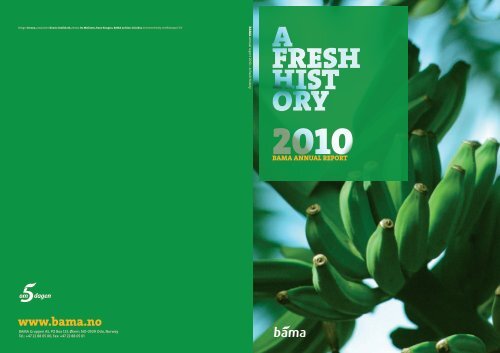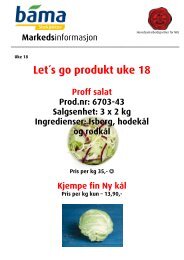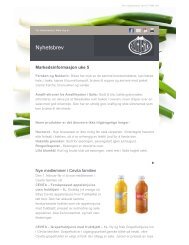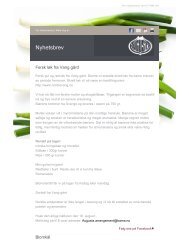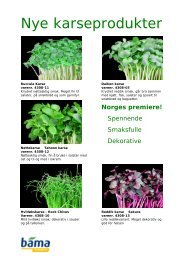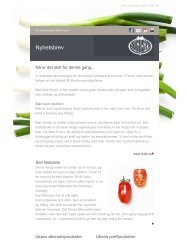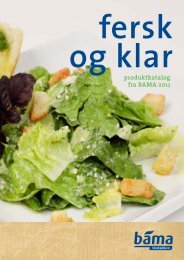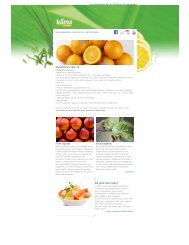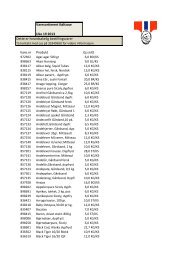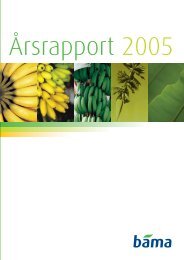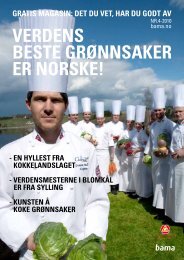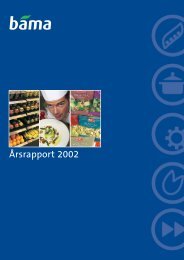Bama Gruppen
Bama Gruppen
Bama Gruppen
- No tags were found...
Create successful ePaper yourself
Turn your PDF publications into a flip-book with our unique Google optimized e-Paper software.
Design: Creuna, production: Konsis Grafisk AS, photos: Bo Mathisen, Rune Kongsro, BAMA archive, Colorbox. Environmentally certified paper, TCF.BAMA annual report 2010 – A fresh historyBAMA ANNUAL REPORTwww.bama.noBAMA <strong>Gruppen</strong> AS, PO Box 123, Økern, NO-0509 Oslo, NorwayTel.: +47 22 88 05 00, Fax: +47 22 88 05 01
Highlights and management reviewmanagement review:record operating resultin turbulent yearDespite a demanding marketBAMA posted its best-ever operating performanceboth in terms of sales and profit margin.This is testament to a robust strategy, excellentadaptability and a highly skilled organisation.At around BNOK 9, sales in 2010 werealmost 8 per cent up on the previous year.The company posted an operating profit ofMNOK 396. This result is particularly satisfyingin light of the turbulent market conditions ateither end of the value chain both in Norwayand abroad. BAMA achieved volume growthof around 3 per cent in 2010, while the overallmarket in Norway returned zero growth. Thismeans that without BAMA’s contribution,the market would have continued to shrink.At 70 per cent compared with 35 per cent,in recent years BAMA’s volume growth hasoutstripped the market by two to one.Strong contribution frominternational businessBAMA’s strong performance in 2010 is in nosmall measure attributable to positive contributionsfrom our international operationsin the Netherlands, Poland and Sweden.Leading the way here is the Netherlandsbasedcompany Nature’s Pride, which isreaping the rewards of its focus on exoticfruit for the European market, and continuedto perform well in 2010. The company boastsformidable expertise in exotic produce andrelated processing. Nature’s Pride’s results for2010 are recognised in BAMA’s consolidatedfinancial statements in line with BAMA’s proratashareholding in the company.Strong grocery sales in Norway also made animportant contribution to the result, not leastbecause groceries account for 70 per cent ofBAMA’s sales. The aim in this segment is forgrowth in fruit and vegetables to outstripgrowth for the segment as a whole. This issomething we have achieved in recent years,including in 2010. The above results wereachieved despite the fact that the Norwegiangrocery store chain Bunnpris ended its collaborationwith Norges<strong>Gruppen</strong> in 2010. Withthe exception of the stores at Møre, this alsomeant that the chain was no longer a BAMAcustomer, and reduced BAMA’s sales throughNorges<strong>Gruppen</strong> by around 6.5 per cent.The Service market area was hit extra hard bychanges in the market, not least due to thefact that our products at petrol stations andkiosks are encountering tougher competitiondue to longer opening hours in the grocerysector as a whole. We are continuing to targetproduct development in this area, at the sametime as achieving efficiency improvements inproduction and distribution through improvedresource utilisation in the rest of the BAMAsystem. Other areas essentially performed inline with expectations, and are continuing topursue established strategies.International unrestThe finance crisis was also felt in 2010, and theNorwegian fruit and vegetables market is stillfeeling the impact of the slump experiencedin 2009. Despite this, industry sales bottomedout in 2010, which we interpret as a signalthat the market is about to turn. Nonetheless,a number of factors are fanning continueduncertainty both in Norway and abroad. TheE. coli scare in Germany in spring 2011 halvedfruit and vegetable sales in Europe, and it willtake some time to fully restore confidencein this product group. In addition, the entireEU area, and in particular Spain and Greece,is being beset by major financial problems.The fruit product group would appear to beparticularly vulnerable in times of recession.Globally we are seeing that the expansion ofKEY FIGURES 2010 2009 2008 2007 2006MNOKINCOME STATEMENTOperating revenues 9 006.8 8 359.0 7 924.7 7 055.1 6 411.3Operating profit 395.9 363.3 299.0 317.9 362.7Profit before extraordinary items 401.2 391.4 300.3 475.1 375.8Profit on ordinary activities after tax 1 259.1 273.6 202.5 368.1 261.2BALANCE SHEETCurrent assets 1 606.4 1 255.6 1 188.4 1 205.3 1 200.8Non-current assets 1 130.3 986.1 1 027.1 803.8 783.5Total assets 2 736.7 2 241.7 2 215.5 2 009.1 1 984.3Current liabilities 1 747.1 1 480.6 1 529.3 1 408.7 1 366.6Long-term liabilities 246.8 152.5 148.6 115.9 141.0Equity (incl. minority interests) 742.8 608.6 537.6 484.5 476.7LIQUIDITYStatement of cash flow 2 443.6 445.8 356.7 490.6 379.6Net interest expenses (+) / income (-) -5.3 -28.1 -1.3 -157.2 -13.1KEY FIGURESLiquidity ratio 1 (%) 3 91.9 84.8 77.7 85.6 87.9Profit ratio (%) 4 4.7 4.8 4.2 6.9 6.0Inventory turnover rate 5 8.7 10.7 9.1 11.1 9.5Total return (%) 6 40.4 52.0 38.4 76.2 57.5Equity ratio (%) 7 27.1 27.1 24.3 24.1 24.0Customer days sales outstanding 8 20 21 23 22 22Supplier days payable outstanding 9 26 25 26 28 29Inventory storage (days) 10 8 7 7 13 19Inventory storage excl. Gro Industrier (days) 10 8 7 7 7 7Sales per full-time equivalent (MNOK) 11 4.6 4.6 4.2 4.1 3.9Definitions:1. Profit/loss before extraordinary items after tax.2. Profit/loss after tax on ordinary activities and depreciation and amortisation.3. Current assets as a percentage of current liabilities.4. Operating profit/loss + financial income as a percentage of sales revenues.5. Operating revenues / Current assets – interest-free liabilities + non-currentassets (Interest-free liabilities = current liabilities – bank overdrafts +deferred tax)Fruit and vegetables, volume growth%807060504030201002000 2001 2002 2003 2004 2005 2006 2007 2008 2009 2010• BAMA volume percentage growth since 2000• Total market percentage growth since 20006. Profit ratio x stock turnover rate7. Equity 31 Dec x 100 / Total assets8. Trade receivables average of 1 Jan and 31 Dec x 360 / Sales revenues x 1.149. Trade payables average of 1 Jan and 31 Dec x 360 / Purchase of goods x 1.1410. Inventories average of 1 Jan and 31 Dec x 360 / Cost of goods sold11. Operating revenues / Full-time equivalentsSource: BAMA/OFG/SSB/SLF69%35%Innovative product development and activemarketing have underpinned BAMA’s growth.12 BAMA annual report 2010BAMA annual report 2010 13
the middle classes in countries such as India,China and Brazil are building pressure onprices and access to goods, in particular withregard to high-quality fruit. Climate changesand natural catastrophes in many parts of theworld have made life hard for many producers.With 64 per cent of our goods flow comingfrom imports, these developments are furtherexacerbating BAMA’s already challengingoperating environment. On the upside, itshould be noted that Norway is bucking thedownwards trend within fruit and vegetables.While consumption has plummeted acrossthe rest of Europe, Norway has posted around14 per cent growth over the last five years.It should also be borne in mind that fruitand vegetables are growing relative to othergrocery categories in Norway.Correct response and active trainingOur results in 2010 are in no small part attributableto our ability to develop and presentnew products and concepts demanded bythe consumer and our professional partners.This ability will continue to be pivotal to oursuccess. Product development will alwaysinvolve striking a balance between supplyingwhat the market wants and influencing themarket by offering new variants. As a majorcompany, BAMA has a clear ambition of generatinggrowth within our industry. We willachieve this by combining innovative productdevelopment with active marketing. In 2011 wewill step up our initiatives in innovation, marketingand consumer education. We will investa record MNOK 80 in marketing. Trend monitoringwill continue to play a key role. A lookat long-term consumer trends in Norway andabroad reveals that customers are increasinglydemanding lighter products – “less cabbageand more salad”. This same principle applies toboth fruit and vegetables. This also means thatthe focus will shift from volume (weight) tovalue as a measure of progress.In light of the E. coli outbreak and the ensuingfrenzied media attention, it will also be criticalthat we continue our systematic work on foodsafety along the entire value chain. BAMA hasa clear goal of setting the industry standard inthis important arena. Consumers must havecomplete confidence in eating fruit and vegetablesin Norway. With regard to corporatesocial responsibility, we will also further pursueour targeted initiatives within the areas ofethical trading and the environment – both ofwhich are of particular importance in light ofBAMA’s global sphere of operations.Necessary reorganisationIn 2009 the BAMA Group embarked on areorganisation process intended to establishindependent market and results responsibilitiesin the respective business areas. In formalterms this means that the units will becomeseparate limited companies rather than divisions.This process continued though 2010and is still ongoing in 2011. BAMA shall firstand foremost achieve growth organically, andwe believe the above type of focus facilitatesthis. It will also positively impact efficiencyimprovement initiatives. This is a demandingprocess for everyone involved, but we firmlybelieve that we must pool resources andsharpen our specialist focus in the individualbusiness areas in order to successfully leverageour full potential and achieve our goals.Unique strength in the organisationBAMA is an expertise-based organisation.Many of our staff have been in the trade formany years and have acquired invaluableexpertise and experience, which really comesinto its own in volatile markets. Together withnew heads and new ideas this creates anorganisation of which management is justlyproud. This is BAMA’s actual engine. An enginerequires maintenance, lubrication and fuel, andto this end we continued to prioritise HR workin 2010. One of the results of the above wasthat the sickness absence rate was reduced to6 per cent in 2010 from 7.6 per cent in 2009,which has generated major cost reductions inaddition to a number of more general benefits.In 2011 BAMA aims to achieve volume growthof 8 per cent. Our results in 2010 lead us tobelieve that we have embarked on the correctcourse, and we are looking forward to furtherpursuing our vision: BAMA – making Norwayfresher and healthier.BAMAGRUPPEN ASGROUPSTAFFTRADINGBAMAGROCERYBAREOPERATIOINSBAMAHORECABAMASERVICE-MARKETBAMAFLOWERSBAMAINDUSTRYBAMAREAL ESTATEBAMA’s Group managementin 2010 comprised (from left):Øyvind BrisåGroup Director IncomingGoods Flow, Packaging andLogisticsAtle BeyerGroup Director Industryand Processing BusinessOdd Lindstad JohansenGroup Director HoReCa,Service Market, Propertyand In-house LogisticsJarle GjerdeGroup Director Finance,Treasury, IT and HRWenche HolenGroup Director Flowersand Strategic ProcessesRune FlaenCEOBAMA annual report 2010 15
groceryFollowing the downturn in 2009, theoverall market for fruit and vegetables postedcautious growth in 2010. Annual sales for thisbusiness area were broadly on a par with theprevious year, but with a marked improvementin the second half of the year.bAMA’s deliveries to the grocerymarket are made through twosales channels, BAMA Grocery(Norges<strong>Gruppen</strong>) and BAREOperations (REMA 1000). Our main focus isthe same in both channels: to help our chaincustomers achieve their targets. This requiresus to actively contribute to the realisation oftheir concepts. One example is REMA 1000’slarge new model store in Lillestrøm, with anin-store “fresh produce market”. Our abilityto make a positive contribution to suchinitiatives is critical for our development.A related target is generating above-averagegrowth in our sector – ensuring that fruitand vegetables achieve higher growth thanthe sector as a whole. We have achieved thistarget in recent years, including in 2010.Highest growth in low priceIn overall terms the low-price chains aremaking the greatest sales contributions, withKiwi and REMA 1000, which both boosted theirmarket share for fruit and vegetables duringthe year, leading the way. We interpret thisdevelopment as a sign that we have succeededin our objective. The supermarkets too arebouncing back after a weaker perfor mance in2009. With the exception of its Møre stores,the Bunnpris chain ended its collaborationwith BAMA in 2010. This reduced BAMA’sgrocery division sales by around 6.5 per cent.Trøndelag and Nordland, which are hometo the Bunnpris chain’s main markets, werehardest hit by this development. Despitethis, the division’s overall sales were up3.7 per cent on 2009. Work on cost efficiencyimprovements continued throughout theyear, with a particular focus on the areaswhere sales have been reduced by the loss ofBunnpris as a customer.Choosier customersThe recovery in the global economy followingthe finance crisis is helping to push up fruitand vegetable prices. At the same timeconsumers are becoming more aware withregard to nutritional value, quality andselection. Many consumers are demandingmore taste and more variants, a trend whichis reflected, for example, in offerings oftomatoes, which have expanded significantlyin recent years. The public is also increasinglyseeking out a greater selection of “freshproduce” in the form of ready-cut fruit andvegetables. The chains have to respond tothese trends through their concepts, whilerecognising that a major portion of thecustomer group is price-conscious.Clear target of higher salesBAMA will continue to work closely with thechains to boost sales per customer and makefruit and vegetables a growth driver. Weshall build further on the positive trend seensince the end of 2010 and aim to achieve aclear volume increase in 2011. BAMA’s chaincustomers have laid down clear growthtargets for the next few years and the divisionaims to contribute by ensuring that fruitand vegetables achieve higher-than-averagesector growth of 8–10 per cent. Our mostimportant contribution will be to becomeeven better at delivering the right selectionof fresh, tempting produce at the right price.At the same time we must be familiar withthe chains’ strategies and philosophies andoffer our expertise to help them succeed,for example through in-store training. Wewill continue to draw on BAMA’s cumulativeexpertise, including by developing newfreshly processed products and variants incollaboration with the industry division.Sales performance20062007200820092010Grocery comprises two main sales channels: Norges<strong>Gruppen</strong> (NG)and Rema 1000 (BaRe). Norges<strong>Gruppen</strong> includes the chain profilesMeny, Ultra, Spar, Joker, Kiwi and the associated local chainsCC, Safari, and Helgø Matsenter. Norges<strong>Gruppen</strong>’s goods flow isorganised and operated through BAMA Grocery and similarly forREMA 1000 through BaRe Operations.6 529+ 3.7%6 296+ 9.6%5 747+ 13.1%5 027+ 17.7%4 272+ 12.9%16 BAMA annual report 2010BAMA annual report 2010 17
HoReCaThe market for fruit and vegetables forHoReCa stabilised in 2010 following a markeddownturn in 2009. Many factors are makingBAMA optimistic about future developments,not least higher sales to the public sector.bAMA HoReCa’s business areaserves the market through threesales channels: HoReCa (hotel,restaurant and catering), pubicsector and the business market. BAMA aimsto be perceived as the customer’s best partnerin all the above channels. The offering catersfor all needs 24 hours a day, and includesconcepts for breakfast, lunch, evening mealsand snacks. Total sales fell by 0.9 per cent in2010. However, sales rallied strongly in thesecond half of the year, a trend which looks setto continue in 2011. The greatest contributioncame from public sector sales, which wereup more than 12 per cent. Several major newcontracts were gained in this channel on theback of a committed focus on competitivetenders. The growth in the public sectorwas achieved despite a 13 per cent fall inofficial sales of subsidised fruit to Norwegianschools under the “Skolefrukt” scheme.Business market sales are roughly at the samelevel as in 2009, while the HoReCa marketslipped back slightly. The year also presentedchallenges in the form of ever-increasingcompetition, not least from small local andregional companies who are merging to formmore effective entities.More BAMA on your plateInnovation is critical for success in the HoReCamarket. We monitor trends and maintainan active dialogue with our customers inorder to highlight new needs and wishes.We collaborate closely with both BAMAIndustry and BAMA Trading on new conceptsand products. Several new concepts wereintroduced last year, including Brain Food forthe Radisson Blu hotels (launched 2011). Underthe slogan “More BAMA on your plate” wehave systematically worked to raise awarenessthat more fruit and vegetables on guests’plates reduces costs – and make meals moretempting and colourful. Our product quality,innovation and delivery precision are highlyvalued in the market. This was confirmed yetagain by 2010 “Supplier of the Year” awardsfrom Umoe Restaurant Group, Choice Hotelsand Gress-gruppen (a purchasing partnershipbetween Rica Hotels, Compass Group Norgeand The Rezidor Hotel Group).Target of outstrippingmarket growthProduct development will also play a key rolein future initiatives and will be based on anumber of clear market trends: the desirefor healthy, nutritious and preferably shorttravelledfood delivered through concepts thatare easy to handle and serve. It is important tobe able to respond rapidly to new wishes andneeds and the partnership between BAMAIndustry and BAMA Trading will continue tobe pivotal in this respect. BAMA HoReCa hasdrawn up a strategy plan to 2014 designedto ensure that the division achieves highergrowth than the market as a whole. The planis firmly embedded in our desire to be thebest collaboration partner for our customers.This in turn requires us to lead the way inproduct development and innovation, andwith this in mind we have been focusingparticularly strongly on the final stages of thevalue chain. In parallel with this, initiativesto make operations more cost-effective arecontinuing. The above measures are intendedto enable the business area to consolidate andstrengthen its leading market position overthe next few years.Sales performance15%20062007200820092010BAMA HoReCa is a market leader within the sale, marketing anddistribution of fruit and vegetables to the HoReCa market inNorway. The business area serves the market through three mainsales channels: HoReCa (hotel, restaurant and catering), pubic sectorand the business market.1 316- 0.9%1 329- 5.8%1 411+ 14.3%1 235+ 18.1%1 045+ 2%18 BAMA annual report 2010BAMA annual report 2010 19
industryFreshly processed products are animportant means of boosting total consumptionof fruit and vegetables. As a leading supplierwithin this segment, BAMA Industri notedseveral positive development traits during 2010.BAMA Industry’s products reachthe consumer through groceryand HoReCa channels alongwith other, external customersegments. The business area’s productionincludes freshly processed and sandwichproducts. Therefore close collaboration withall the channels is decisive in ensuring thatproducts meet customers’ needs. Sales in2010 were on a par with the previous year.An upturn in the market was evident in thesecond half of the year, and continued into2011, reflecting general macroeconomicdevelopments. Consumers are increasinglydemanding simple, fresh and healthy mealsolutions, and freshly processed variants arecontributing an increasing share of total fruitand vegetable sales. Ready-cut salads haveproven to be a particular favourite with thepublic. A range of new product variants waslaunched in 2010 to accommodate this trend.There is also growing interest in the HoReCamarket, where ready-cut products free uptime for other areas of food production andguest service.New plants openedBAMA Industry’s products are based on thebest ingredients from selected producersin Norway and abroad. The core productsare potatoes, salads, vegetables andsandwiches. The ingredients are processedand packed carefully to guarantee firstclassquality. The critical factors for successare top product quality, the right price anda range that appeals to consumers anddistributors. To improve our performanceeven further in these areas a reorganisationwas implemented in 2010 involving therecomposition of the entire product range. Inaddition, new plants were opened in Tromsøand Bergen to produce sandwich products.The working environment represents anotherprioritised area, and in 2010 our initiativesin this respect received an extra boost whenBAMA Industry was named the year’s bestInclusive Workplace in Buskerud.Strong growth ambitionsBAMA Industry has ambitious aims for thefuture, and wishes to double sales by 2014.The growth is expected to be generated inthe defined core areas of potatoes, salads,vegetables and sandwich products, and wewill actively monitor fruit and vegetabletrends, not least abroad, and develop ourproduct portfolio accordingly. The overarchingaim is to make it easier for the consumerto choose healthy alternatives – they shallexperience added value as well as save time.In line with this ambition we are launchingtwo brand new product categories in 2011:Baby Leaf (small, early-harvested younglettuce leaves) and chopped vegetables.We will also maintain a sharp focus on costsand strive to make the value chain evermore efficient through expertise building,technology development and optimallogistics. In organisational terms we willconcentrate on our existing foundations, andmanagement’s agenda will continue to bedriven by our “5-a-day” list: quality, productdevelopment, cost-efficiency, HR managementand sales.Sales performance20062007200820092010BAMA Industry produces freshly processed and sandwich productsto BAMA’s HoReCa and grocery customers, in addition to other,external customer segments. The product range varies fromready-cut salads and vegetables to cream-gratinated and cookedpotatoes, along with meal solutions and several other raw andcooked products.486- 3.3%503+ 3.8%485- 0.1%485+ 18.8%409+ 22.5%20 BAMA annual report 2010BAMA annual report 2010 21
service marketThe market served by this businessarea is coming under pressure from severaldirections. In 2010 reorganisation, a focus onproduct development and promising results inSweden strengthened the division’s platform forfurther development.bAMA Service Market suppliesfruit and vegetables, drinks, mealsolutions and sandwich products,primarily to kiosks and petrolstations. This channel has been under pressurefor several years. Significantly extendedopening hours for grocery stores havehelped push down sales of groceries in otherdistribution channels. This is reflected in thedivision’s sales for 2010, which were roughlyon a par with 2009, itself a year of recession.The situation necessitated a critical review ofoperations, which revealed that distributionaccounted for too much of the company’s costbase. The business was therefore reorganisedso that product management was spun offto BAMA’s other business areas. Thus freshproducts are now delivered by BAMA Trading,processed products by BAMA Industry, whilecustomer service is performed by BAMAHoReCa. The formal reorganisation wasimplemented in late 2010, while 2011 willbe the year of full implementation. Anotherimportant feature of the year under reviewwas the return of Statoil as a sandwichproducts customer. Statoil is the market’slargest player, contributing 30 per cent of thedivision’s sales.Breakthrough in SwedenBAMA has established a strong position inSweden through its wholly owned subsidiaryNordic Lunch, which specialises in salads andsandwich products. Important customersinclude the kiosk chains Pressbyrån and7-Eleven, both of which are owned by Reitangruppen.Two major new customers weregained in 2010 – Statoil in Sweden and thepetrol station chain OK Q8. 2010 was thus abreakthrough year for BAMA in neighbouringSweden, where sales for 2011 are expectedto be 100 per cent up on 2009. This successwas achieved as a result of a long-term andsystematic approach and BAMA’s reputationas a highly professional company. Significantexpansion is planned on the back of thesenew agreements. The main hub of activitiesfor the above will be the strong local expertisepool in Lindesberg, north of Örebro. An agreementhas also been signed to lease productionin Varberg in southern Sweden. Nordic Lunchalso owns a logistics company in Sweden –Landet Rundt. However, poor recent resultsfrom the latter may necessitate restructuringmeasures in 2011.Product development is the keyCustomers in the service market segment arereceptive to new products and concepts. This isreflected, for example, in the success of “Good”brand salads in Sweden. Thanks to high quality,customer-orientated packaging and accessories,the product was chosen as “Product ofthe Year” by 7-Eleven in Sweden in 2010. So successfulwas the launch that the Reitan grouphas decided to replace its own label productwith the Good brand. The above success showsthat product development and innovation arealso the key to generating growth within theService market. Despite a professed desire onthe part of consumers to eat more healthily,the offering of fruit and vegetables has notexpanded in this sales channel in recent years.BAMA will align itself with the chains and salesoutlets and develop products and concepts toincrease the number of customers and boostsales per customer. We aim to provide kiosksand petrol stations with a fresher and healthierprofile. Together with a new operatingstructure in Norway and an ongoing focus inSweden, this will provide a platform for longtermprofitability within the service market.Sales performance20062007200820092010BAMA Service Market supplies fruit and vegetables, drinks, mealsolutions and sandwich products to the kiosk, petrol station andservice market and the grocery trade. The business area also hassignificant operations in Sweden through the BAMA-ownedcompany Nordic Lunch.276+ 36.6%202- 17.2%243+ 45.7%167+ 14.4%146+ 22.9%The figures apply to sales in Norway.22 BAMA annual report 2010BAMA annual report 2010 23
flowersFlowers is a new and important focus areafor BAMA. In 2010 the business area consolidatedits market position and garnered manyimportant experiences for further work. Theestablishment of a separate trading business forflowers represented an important milestone.bAMA offers flowers to Norwegianconsumers through a numberof sales channels. In thegrocery trade we deliver toNorges<strong>Gruppen</strong> (NG) and REMA 1000 (BaRe)in line with the same model as for fruit andvegetables. BAMA’s flowers are also sold atpetrol stations and in kiosks. The businessarea additionally includes specialist storesgroup Floriss, which is a leading franchisebasedchain with 89 stores. BAMA thus enjoysa wide-ranging presence in this segment,and a solid platform for future development.Results for 2010 came in slightly lower thanexpected, but were nonetheless slightly up onthe previous year.New trading business establishedJanuary 2010 saw the establishment of thenew company BAMA Blomster Trading AS. Thecompany is responsible for all flower suppliesto units in the business area and the rest ofthe Group. BAMA purchases flowers from abroad range of suppliers in Norway, otherEuropean countries such as Denmark and theNetherlands, and Africa. Controlling the goodsflow is critical for ensuring efficient operationsand high quality. In the same way as for fruitand vegetables, consumers of flowers areswayed by high-quality, appropriately-pricedattractive and fresh products.Nuanced approach requiredFlowers are also similar to fruit and vegetablesin that customers’ preferences areforever changing. For example, recent yearshave seen a clear move away from pottedplants to cut flowers. Trend-monitoring andactive concept development are thereforekey activities. These must be performedwith a nuanced approach, as BAMA sellsflowers through sales channels of differingnatures. In the grocery trade it is importantfor offerings to be attractive and readilyavailable, yet robust and predictable. Hereconcepts are developed in close collaborationwith the chains, where it is important to getconsumers to appreciate that the flowersin the grocery stores are of good quality.The Floriss chain’s specialist stores requirea wider and more sophisticated selectionand highly knowledgeable service staff. In allsales channels, BAMA extensively develops itsoffering by testing concepts and monitoringsales performance for the products concerned.This is particularly important due to the factthat little objective, quantitative market datais externally available for flowers.Dedicated ongoing focusBAMA has defined flowers as a strategicgrowth-driver for the future. The companywill adopt a deliberate focus on cultivatingmarket positions, not least within grocerywhere the largest growth is expected to beachieved. Flowers did not become a separatebusiness area until 2008, and we are still inan expertise- and experience-building phasewhere we are laying the foundations forfuture work. Expertise exchange with the restof the BAMA organisation will be important,while we will also remain attentive to thespecific challenges in the market for flowers.Sales performance20062007200820092010BAMA’s activities within flowers are operated through BAMA Flower(grocery and service market), Floriss Drift (specialist stores) andBAMA Flower Trading (purchasing) . The units are included in BAMAFlower Holding, which is owned by BAMA <strong>Gruppen</strong>.590+ 16%508+ 8%470+ 25.9%374+ 11.7%334+ 6.3%Incl. franchise sales.24 BAMA annual report 2010BAMA annual report 2010 25
BAMA’s corporate social responsibilityTargets for 2010EcuadorContinue permanent followupin Ecuador, now also withregard to the flowers sectorand pineapple producers.Project Building Education, ajoint project between the localunion, the authorities, Doleand BAMA.Costa RicaExtend work to cover theentire banana industry in thearea, including unions andthe authorities in addition tothe Norwegian Confederationof Trade Unions (LO), theFederation of NorwegianCommercial and ServiceEnterprises (HSH) and theNorwegian Ministry of ForeignAffairs (UD) as part of thefollow-up of the Memorandumof Understanding whichBAMA entered into with UDin 2009. Tesco is also activelyparticipating.Strengthen collaboration withBananalink.South AfricaContinue project in SouthAfrica focusing on boostingemployee representativeinvolvement in projectimplementation.Corporate social responsibility in practicestatusCommercial pineapple projects have been trialled. No flowers-relatedprojects were initiated during 2010.New school room in Rio Viejo opened in 2010. New funds granted forcommunity development in accordance with the same model.Several meetings were held with the CSR Director and Corbana (theCosta Rican Banana Corporation). A major conference was held andattended by participants from the entire industry in Costa Rica, theNorwegian ambassador along with representatives from BAMA, LOand HSH.Project application submitted by LO and HSH to UD for project supportto reinforce three-party collaboration in Costa Rica in accordance withBAMA’s model. The project runs until 2013.Economic support from Parat in BAMA for training the Cosiba CostaRica union’s employee representatives.Effective and direct contact several times a year.Greater involvement on the part of employee representatives hasstrengthened collaboration with the union, although this work hasbecome more demanding as a result of the latter’s incorporation intothe national union.CO 2emissions, where the greatest improvements came from energysavings and waste management. Emissions from internally ownedtransport and fossil fuels increased by 6.8 per cent. The results areused as a basis for improvement measures. The target for 2011 is areduction in CO 2emissions of 5 per cent. BAMA is also participatingin a joint project intended to establish a separate standard for carbonfootprints – i.e. to map a product’s total environmental impactfrom production to consumption. BAMA aims to identify the carbonfootprint for 80 per cent of its total sales volume by 2015.From road to rail. An important environmental target is to move anincreasing percentage of transport activities to the railways – bothwithin Norway and on the continent. BAMA’s transport strategytherefore has a clear railway focus. One specific target is to ensurethat half of all incoming goods are transported by rail by 2020.Action plan for packaging. In 2009 BAMA adopted a dedicatedaction plan for packaging. From an overall perspective packaging hasa positive environmental impact on our business in that it reduceswastage along the value chain – as it means fewer products have tobe thrown away. The action plan aims to develop packaging solutionsthat provide optimal protection for goods during transport.Eco-Lighthouse. All the operating units in the HoReCa and grocerybusiness areas are due to be certified as Eco-Lighthouses during 2011.The Eco-Lighthouse scheme is a Norwegian certification programmethat helps businesses to operate in an environmentally friendlymanner and establish a clear environmental profile. The businessesundergo an environmental analysis, and if they satisfy a set of definedindustry requirements, they are accorded Eco-Lighthouse status. ForBAMA this involves a particular focus on energy, transport, purchasingand waste management. A total of 12 departments were certifiedas Eco-Lighthouses in 2010, and the remaining departments will becertified in 2011.Quality and food safety. Guaranteeing high product quality not onlysecures a competitive advantage – it is also part of our corporate socialresponsibility remit. Consumers must have complete confidence thatgoods delivered by BAMA are safe to eat at all times. We continuedto make quality improvements in 2010. The Group slightly exceededpermitted pesticide levels in its products on a few occasions; however,none of these incidents posed a threat to health. The average internalclaims cost decreased further, from 0.66 per cent to 0.50 per cent.12 00010 0008 0006 0004 0002 000Emission sourcesFlightsElectricityVehicle transportand fossil fuelTotal CO 2emissions are down by 4.4 per cent, wherethe largest decrease is attributable to a reductionin waste.Pesticide residuesClaimsTotalWaste• 2009 • 20107550352315743502006 2007 2008 2009 2010• BAMA • IndustryPesticide residues were found to exceed permittedthresholds in five products. None of the incidentsposed a threat to health.GuatemalaFollow-up of ongoing projectin Guatemala.Israel/PalestineStrengthen collaborationbetween producers/exportersin Israel and Palestine.NorwayFollow-up of Norwegianproducers in collaborationwith Gartnerhallen regardingsocial dumping.Need for stronger management of project in Guatemala. Furthermeasures and stricter follow-up to be implemented in 2011.Follow-up of producer, check validity of claims of child labour inPalestine. Promotion of market orientation towards the West withregard to export business.Collaboration with the United Federation of Trade Unions in LO inrelation to the agriculture sector. On one occasion supplier purchaseswere suspended until the requisite documentation and clarificationshad been furnished.The introduction of an automatic monitoring system to measure theideal temperature during transport of products from Europe helpedto cut temperature non-compliances by 60 percentage points andsignificantly raise product quality.BAMA has implemented an HACCP system (Hazard Analysis andCritical Control Point) which focuses on food safety and analysis of thevalue chain in relation to critical points. This forms the basis for furtherdevelopment of requirements of suppliers and for systems intendedto secure food safety. BAMA adopts Global GAP and KSL as definedquality standards for primary producers in both Norway and abroad.In addition, the company’s fresh salad production plants are certifiedin accordance with the British Retail Consortium (BRC) standard.In 2010 a small batch of imported lettuce was recalled due tosuspected microbiological contamination.20092008200720060.50%0.66%0.87%0.83%0.96%A focus on preventative measures is helping to cutaverage claims costs.28 BAMA annual report 2010BAMA annual report 2010 29
ama’sculturecorporategovernanceBAMA has constantly striven to cut itssickness absence rate since 2009. Thanksto preventative measures and effectivecommunication, we achieved our best-everresults in 2010.As part of our drive to permanently cut the sicknessabsence rate, we continued our management traininginitiatives in this area in 2010. This involved ongoinghighlighting of issues relating to sickness absence workand preventative measures, and facilitation of betterdialogue between managers and staff.Preventative HSE measures included a deliberate focus oncorrect lifting techniques and employees’ responsibilityfor looking after their own health. The company has alsofocused on encouraging employees signed off as ill to workreduced hours, wherever such is feasible. Experience showsthat employees return to full-time work more quickly – anaim shared by both parties – under such circumstances.Follow-up of sickness absence has now been incorporatedinto managers’ daily routines, resulting in record-lowsickness absence in 2010 of 6 per cent, compared with7.6 per cent in 2009. This extremely pleasing result, whichis attributable to efficient personnel management, hasalso generated significant cost reductions.Inclusive Working Life (IA) business in 2010High sickness absence has also been a problem in the pastat BAMA Industrier AS’s salad factory. However, mapping ofsickness absence together with the adoption of ambitioustargets has made it possible to implement systematic andinclusive measures at all levels in the factory. A consultantfrom the Norwegian Labour and Welfare Service (NAV)assisted in the process, which also involved the HR departmentand the occupational health service. In 2010 the saladfactory was awarded the IA prize from NAV Arbeidsliv inBuskerud for its work in this area with the following citation:“Few businesses focus more strongly on IA; both thecommitment and results are impressive.”Improving health with BAMA PlussPreventative employee-targeted health initiatives haveplayed an important role in keeping sickness absence atgenerally low levels for a number of years. BAMA Pluss isan employee-orientated concept focusing on diet, physicalactivity and mental health. The concept is intended toestablish healthy fundamental attitudes throughout theorganisation. Specific measures implemented include theprovision of a ready supply of fruit, vegetables and waterduring working hours, discounted personal purchases,healthy lunches, annual health checks and facilitation ofparticipation in physical activities.Consistently high levels of job satisfactionSatisfaction surveys are conducted each year throughoutthe organisation. The results reveal high levels of employeesatisfaction. BAMA has a long-standing culture of taking careof its employees. With major ethnic and cultural diversityamong our staff, we are keen to create an inclusive workinglife for everyone. BAMA shall be a safe and attractive workplace.This goal, which requires a mutual focus on respect,trust and dialogue, is embraced by the entire organisation.Effective collaboration with employee representative bodieswill be pivotal for BAMA’s future performance.Sickness absence8.4%Industry7.5% 7.6% 7.9%NorwayIndustry6.8%Norway2009 20106%BAMA <strong>Gruppen</strong> AS is a leading company and a trendsettingsocial player within fresh and freshly processedfruit and vegetables, and flowers in Norway. The companyoperates in a global market, which entails a significantresponsibility in terms of food safety and corporate socialresponsibility. Effective business management shall contributeto increased growth, value creation and a goodreputation.Corporate governanceIn accordance with the Norwegian Limited LiabilityCompanies Act, the company’s board is responsible forensuring that the company’s business and administrationare properly organised. BAMA <strong>Gruppen</strong> is run as anautono mous and independent company. It has a groupstructure whereby the respective business areas are constitutedas independent limited companies, with ownboards with corresponding responsibility for the individualcompanies.Core valuesBAMA <strong>Gruppen</strong> AS demands honesty, integrity and fairnessin all matters relating to our business activities. Intheir conduct, all staff and representatives in all companiesin the Group shall promote the company’s core values,comply with applicable regulations and legislation at alltimes and perform their work in accordance with goodbusiness practice. BAMA <strong>Gruppen</strong>’s ethical guidelines canbe viewed at www.bama.no.The businessBAMA <strong>Gruppen</strong>’s Articles of Association establish that thecompany’s objects comprise performing trading, industrialand investment business and other related activities,including participating in other companies.BAMA <strong>Gruppen</strong>’s vision is to make Norway fresher andhealthier. The main objectives are for the company to beperceived as the best supplier and partner for its customersand to be a growth driver in the Norwegian market. Theannual value growth shall be at least 8 per cent and thevolume growth shall equate to at least 4 per cent.Share capital and dividendsAt the end of 2010 the Group’s equity totalled MNOK 742.8and was thus in line with the board’s target of an equityratio of at least 25 per cent. The board adopts dividendsthat are in line with the provisions contained in the shareholderagreement, and involve a market-based return oninvested capital for the shareholders.ShareholdersBAMA <strong>Gruppen</strong> has three shareholders: Norges<strong>Gruppen</strong>ASA (46%), AS Banan (34%) and Rema Industrier AS (20%).There is one share category and each share carries one vote.The guidelines are established by the company’s owners.TradabilityThe company’s Articles of Association and shareholderagreement contain provisions on the tradability of theshares.General meetingThe annual general meeting is held once a year by theend of June. Notice of the general meeting, the notice’scontents and publication of the agenda documents complywith the requirements laid down by the NorwegianLimited Liability Companies Act and the rules of procedurefor general meetings.The boardThe board comprises nine members. The general meetingelects the board chairman. There are three employeerepresentatives on the board. No representatives ofthe general management team sit on the board. Theowners exercise their influence through the board andin the general meeting. The board’s tasks and duties areregulated in the adopted rules of procedure for the board,including handling matters of a competition-sensitivenature relating to the company’s customers.BAMA <strong>Gruppen</strong> has no corporate assembly.Risk management and internal controlsRisks are actively managed. The various risk areas identifiedin the Group are followed up by the administration.Appropriate measures are implemented where required.Corporate governance is otherwise based on theNorwegian Code of Practice for Corporate Governancefrom October 2010.30 BAMA annual report 2010BAMA annual report 2010 31
notesnotesParent companyInsuredschemeUnfundedschemeInsuredschemeGroupUnfundedschemeEstimated pension liabilities -201 828 -92 486 -346 647 -99 779Pension assets (at market value) 143 810 0 237 869 0Actuarial losses/(gains) not recognised in the income statement 65 796 946 104 027 1 290Estimate deviations 17 050 289Employer’s national insurance contributions 1 099 -1 389 -13 918 -2 367Prepaid pensions (net pension liability) 8 877 -92 929 -1 619 -100 567GoodwillCost 1 Jan 2010 11 558Disposals on demerger -11 558Additions 0Disposals 0Cost 31 Dec 2010 0Cumulative amortisation and impairments 31 Dec 2010 0Book value as of 31 Dec 2010 0Amortisation for the year 0Financial assumptions:Discount rate 4.60%Projected yield on fund assets 5.40%Forecast salary increases 4.00%Forecast adjustment of National Insurance Scheme’s basic amount (G) 3.75%Forecast adjustment of current pensions 3.75%Standard insurance industry assumptions have been used as actuarial assumptions for demographic factors and departures.Note 4: Property, plant and equipment / Intangible assetsProperty, plant and equipment is recognised in the balance sheet and depreciated over the asset’s useful economic life, ifthe asset in question has a useful economic life of more than three years and a cost price exceeding NOK 15,000. Directmaintenance of property, plant and equipment is expensed under operating expenses, whereas improvements and upgradesare assigned to the asset’s cost and depreciated in line with the asset. If the fair value of an asset is lower than its book value,and this is attributable to matters not deemed to be temporary in nature, the asset is written down.PARENT COMPANYLandBuildings,fittings andinstallationsFurn., mach.,equip.,tr. meansTotalCost 1 Jan 2010 2 070 199 491 220 523 422 084Additions purchased operating assets 0 3 371 48 185 51 556Disposals 0 -70 873 -16 761 -87 634Cost 31 Dec 2010 2 070 131 989 251 947 386 006Cumulative depreciation and impairments0 -107 091 -136 135 -243 22631 Dec 2010Disposals on demerger -1 623 -13 532 -49 079 -64 234Book value as of 31 Dec 2010 447 11 366 66 733 78 546Depreciation for the year 0 8 946 16 060 25 006Useful economic life 5–25 years 3–10 yearsDepreciation method Straight-line Straight-lineUseful economic lifeAmortisation methodGROUPLandBuildingsFurn., Mach.,equip.,tr. means.5–10 yearsStraight-lineTotalCost 1 Jan 2010 140 393 546 728 985 081 1 672 202Additions purchased operating assets / new32 282 98 399 170 484 301 165Group companiesDisposals -5 004 -57 757 -240 276 -303 037Cost 31 Dec 2010 167 671 587 370 915 289 1 670 330Cumulative depreciation and impairments 31 Dec 2010 0 -263 446 -577 312 -840 758Book value as of 31 Dec 2010 167 671 323 924 337 977 829 572Depreciation for the year 0 32 450 98 663 131 113Useful economic life 5–25 years 3–10 yearsDepreciation method Straight-line Straight-lineGoodwillBrands/conceptsCost 1 Jan 2010 378 396 37 813Additions purchased operating assets / new Group companies 56 579 0Disposals 0 0Cost 31 Dec 2010 434 975 37 813Cumulative amortisation and impairments 31 Dec 2010 -319 993 0Book value as of 31 Dec 2010 114 982 37 813Amortisation for the year 53 318 0Useful economic lifeAmortisation method5–10 yearsStraight-lineBrands/concepts are not amortised but are revalued and subject to an impairment test at the end of each accounting year.46 BAMA annual report 2010BAMA annual report 2010 47
notesnotesCurrent investments:Company name Reg. office Shareholding Voting rights Book valueMisc. other shares and shareholdings 110Investments in life insurance account 5 563TOTAL 5 673Note 6: Intra-group balancesParent company:Trade receivables Other curr. receivables2010 2009 2010 2009Group companies 377 868 136 408 99 402 47 195Merger receivables due from new subsidiaries 0 0 336 198 0Trade payables Other curr. liabilities2010 2009 2010 2009Group companies 99 757 107 778 220 523 16 329Reconciliation of tax expense and tax calculated at nominal tax rate:Total tax expense for the year 45 091Tax calculated at nominal tax rate (28%) of the profit before tax 60 294Variance -15 203The variance relates to the following:Change in deferred tax assets as of 1 JanUnderprovision of tax relating to previous years 4 361Tax on permanent differences -41 178Tax on Group contributions received 18 323Tax on change in temporary differences EMP shares 3 291Total difference -15 203Tax payable for the year comprises:Profit on ordinary activities before tax 215 338Permanent differences -147 065Change in temporary differences 6,794Group contributions received 65 438Basis for tax payable 140 505Tax, 28% 39 341Note 7: Receivables falling due after more than one yearParent company Group2010 2009 2010 2009Other long-term receivables 0 0 10 837 0Intra-group loans 261 333 132 807 0 0Tax payable in the balance sheet comprises: 2010 2009Tax payable on profit for the year 39 341 85 140Underprovision for tax 2006–2007 0 10 199Tax on Group contributions paid -2 591 -1 120Tax reduction as a result of the Norwegian governmental Skattefunn scheme -37Tax payable in the balance sheet 36 750 94 181Breakdown of deferred tax basis 31 Dec 2010 1 Jan 2010Differences that are set off connected to:Note 8: TaxesTAX IN THE PARENT COMPANYThe tax expense for the year comprises the following:Corporation tax payable for 2010 39 341Underprovision of tax relating to previous years 4 361Gross change in deferred tax in balance sheet 1 389Total tax expense for the year 45 091Non-current assets 8 626 2 740Current assets -165 491 -165 730Liabilities -90 852 -71 921Other differences 17 766 0Total -229 951 -234 911Deferred tax assets -64 386 -65 775Taxes are recognised as they accrue, i.e. the tax expense relates to the accounting profit/loss before tax. The tax expensecomprises tax payable (tax on the year’s taxable income) and changes in net deferred tax.50 BAMA annual report 2010BAMA annual report 2010 51
notesnotesNote 9: EquityParent companySharecapitalShare premiumacc.OtherEQuityTotalEquity 1 Jan 2010 900 0 624 695 625 595Change in equity on demerger 348 159 -347 551 608Net profit for the year 170 247 170 247Proposed dividends -150 000 -150 000Equity 31 Dec 2010 900 348 159 297 391 646 450GroupSharecapitalOtherEQuityMinorityinterestsTotalEquity 1 Jan 2010 900 521 563 86 158 608 621Effect of changes in Group composition andshareholdings in consolidated financial statements 17 123 49 116 66 239Translation differences 1 489 1 489Net profit for the year 214 623 44 503 259 126Proposed dividends / minority’s share of dividends -150 000 -42 719 -192 719Equity 31 Dec 2010 900 604 798 137 058 742 756Company Rec. share prem. acc. 31 Dec 2010 Majority shareholding<strong>Bama</strong> Ålesund AS 10 6Larvik Løk AS 160 80Lågen Potetpakkeri AS 968 786K. Skovly Transport AS 10 10<strong>Bama</strong> Industri AS 43 833 40 370<strong>Bama</strong> Telemark AS 709 362Nordic Lunch Produksjon AS 1 1<strong>Bama</strong> Midlertidig 1 AS 1 1<strong>Bama</strong> Midlertidig 2 AS 1 1<strong>Bama</strong> Midlertidig 3 AS 1 1<strong>Bama</strong> Midlertidig 4 AS 1 1Silovegen 10 AS 1 1Silovegen 10 Midlertidig AS 1 1Kildehaugen 10 AS 1 1Kildehaugen 10 Midlertidig AS 1 1<strong>Bama</strong> Dagligvare AS 1 1<strong>Bama</strong> Storkjøkken AS 1 1BaRe Frukt & Grønt AS 1 1<strong>Bama</strong> Eiendom AS 1 1Rudsflata 3 AS 1 1Fruba Eiendom AS 1 1Total 142 099 133 006The majority share of the share premium account in subsidiaries and sub-subsidiaries is recognised in other equity in theconsolidated financial statements.Company Rec. share prem. acc. 31 Dec 2010 Majority shareholding<strong>Bama</strong> Blomster Holding AS 28 508 28 508<strong>Bama</strong> Blomster AS 3 2<strong>Bama</strong> Blomster Trading AS 2 1Floriss Drift AS 1 622 1 217Horeca Logistic AS 15 9Nedre Rommen AS 9 020 9 020Nyland Syd AS 7 503 7 503BaGa Eiendom AS 4 957 3 718Frier Eiendom AS 1 110 1 110Alsaker Frukt og Grønt AS 13 13Mjøsgrønt AS 292 146Nordic Lunch Holding AS 10 600 10 600Fruktengros AS 40 40Nordic Lunch AS 7 050 7 050<strong>Bama</strong> Logistikk AS 3 976 2 029Sandvik Transport AS 2 1<strong>Bama</strong> <strong>Gruppen</strong> Blomster Holding AS 5 217 5 217<strong>Bama</strong> Nord AS 16 464 15 193Note 10: Share capital and shareholder informationOwnership structure Office municipality ShareholdingNorgesgruppen ASA Oslo 46%AS Banan Oslo 34%Rema Industrier AS Oslo 20%AS Banan is fully controlled by the board member Kristian Nergaard and his related parties.Note 11: Long-term liabilities – mortgages and guaranteesLiabilities maturing more than five years after the endof the accounting year Parent company Group2010 2009 2010 2009Liabilities to credit institutions 0 0 53 996 11 042Liabilities secured by mortgages etc.Liabilities to credit institutions 0 0 138 838 52 619The parent company has issued a negative pledge for its total exposure with DnB NOR. In addition to the parentcompany, the subsidiary <strong>Bama</strong> Dagligvare Vestfold AS has pledged trade receivables and transport means and fittings52 BAMA annual report 2010BAMA annual report 2010 53
history2010 historyABOUT A BANANA. At the same timethis is the story of BAMA. We have delivered freshfruit and vegetables to the Norwegian people formore than a century. To be able to do this we havebuilt up our business based on a non-negotiablerequirement for freshness. It’s all about expertiseand experience. It’s a question of precision andadvanced logistics. And it’s about satisfyingever-changing and more choosy demands fromNorwegian consumers.Welcome to BAMA’s 2010 annual report.A FRESH HISTORY.BAMA is Norway’sleading supplier of fruitand vegetables. Ourvision is a fresher andhealthier Norway. In 2011we celebrate our 125-yearanniversary.THIS ISBAMA/PAGES 2–3This is the story 1This is BAMA 2CEO 4From ground to table 6Strategic innovation 8Treading carefully 10THE FUTUREIS FRESH/PAGES 4–5BAMA – perfectly in tunewith important trends:a healthy lifestyleand healthy food.“Changing habits is animportant part of our job,”comments BAMA’s CEORune Flaen.Management highlights 12Grocery 16HoReCa 18Industry 20Service market 22Flowers 24January • Launch of extensive advertising campaignfeaturing sports stars in run-up to Winter Olympics.• Recall of salad products due to high bacteria content.February • Government Food Chain AssessmentCommittee formed to review influence in the grocerytrade sets to work.March • BAMA presents its first carbon accounts.• BAMA, the Norwegian Confederation of Trade Unions(LO) and the Federation of Norwegian Commercial andService Enterprises (HSH) arrange conference in CostaRica for banana exporters and European importers.Topic: CSR in the banana industry.April • BAMA Industri launches several salad andvegetable products.May • Bunnpris ends collaboration with BAMA. • Newthree-year agreement on supply of fruit baskets toDnBNor signed. • Floriss and Servicehandel are keysuppliers to the Eurovision Song Contest. • Launch ofred Cevita juice.June • Highest number of participants in Test ofStrength Trondheim to Oslo Cycle Race ensuresthat BAMA carries off the challenge cup. • In-housetransport business bundled into single company:BAMA Logistikk AS. • Norwegian national cookingteam participates in major campaign for Norwegianproducts.July • Statoil returns as BAMA Servicehandel customer.August • BAMA moves up 6 percentage points inmarket research company Synnovate’s reputationsurvey. • The first five units at BAMA are certifiedas Environmental Lighthouses. • BAMA Industrireceives the Buskerud Inclusive Working Life prize foroutstanding work.November • “Fruit and vegetables are healthy”commercial becomes a hit and achieves nearly300,000 visits on YouTube. • BAMA enters sponsorshipagreement with Norwegian Ski Federation on sportsnutrition.December • No increase in consumer growth for fruitand vegetables in Norway. • BAMA Storkjøkken namedSupplier of the Year by three important customerchains. • BAMA becomes majority shareholder inNature’s Management B.V., the Netherlands. • NordicLunch’s “Good” salads named Product of the Year by7-Eleven in Sweden.1886 – Established as a timber business by founderChristian Marius Emil Matthiessen.1905 – Agreement to supply wooden boxes to transportbananas in the UK and import bananas to Scandinaviasigned. The first bananas arrive in Norway.1915 – Banana imports achieve rapid growth. Ownbranches established in key locations. The expression“Banan-Matthiessen” enters the vernacular.1920 – Import of bananas deregulated in 1919. Thecompany expands strongly and the ripening sheds inStiftsgården and Statholdergården in Oslo are filled tocapacity.1930 – Fyffes bananas are in great demand and a newand modern ripening shed is completed at Filipstadkaiain Oslo.1940 – All import of fruit and vegetables ceases duringWorld War II. The new ripening shed at Filipstad isdevastated by an explosion in 1943.1950 – Currency restrictions introduced and Norwaybecomes a banana-free zone from 1947. The companystarts selling other goods categories. Marketequilibrium reestablished in 1957. Other tropicalproducts incorporated into range.1960 – Import of bananas deregulated after 20 years’scarcity. The company goes nationwide. Norwegianproduction included in the range. Market characterisedby strong competition.1970 – Major construction activity and upgrading oflocal terminals. Strong focus on competence-raising.Regulatory framework strongly impacted by Norwegianagricultural policy and market access secured throughactive organisation business.1980 – The company changes its name to BAMA<strong>Gruppen</strong> AS. Marketing and product training steppedup. Producer organisation BAMA Grønt established.1990 – “5-a-day” campaign launched and majorsponsorship agreements signed. BAMA launchesfreshly processed salads. Major market changes leadto collaboration between Gartnerhallen and BAMA.Long-term partnership agreements entered into withNorges<strong>Gruppen</strong> and Rema 1000.2000 – BAMA’s sales quadrupled over the last ten years.2005 – Banana centenary advertising campaign inNorway; “Bend it like a banana” campaign launchedhelping to stimulate market supply of 200 millionbananas. The TV documentary programme Brennpunktputs critical spotlight on BAMA and the Bend it campaign.BAMA acquires Nordic Lunch in 2007.BAMA annual report 2010 57


